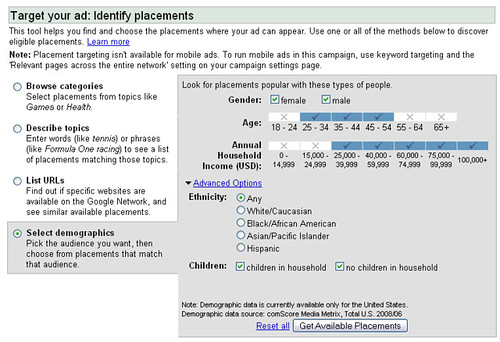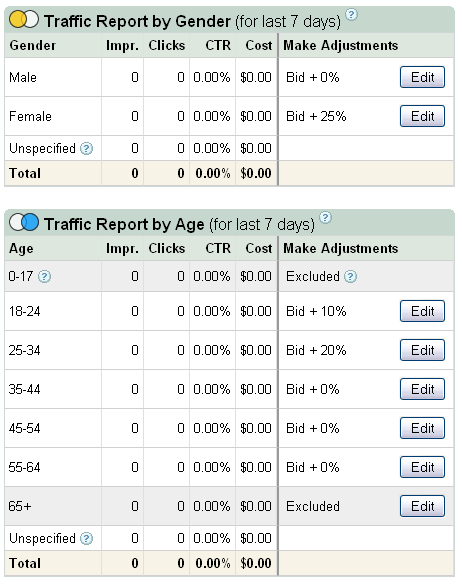Use Demographic Targeting to Reach Your Customers in New Ways
Demographic targeting has long lived within the realm of CPM and banner buys. However, AdWords is becoming much more sophisticated in the ways that you can use demographics within your AdWords campaign. Below are a list of resources for using Demographic Information within AdWords. Find out how various demographics perform for Your account The first […]
Demographic targeting has long lived within the realm of CPM and banner buys. However, AdWords is becoming much more sophisticated in the ways that you can use demographics within your AdWords campaign. Below are a list of resources for using Demographic Information within AdWords.
Find out how various demographics perform for Your account
The first step in demographic targeting is to identify your ideal customer’s characteristics. You can either profile your customer, or you can see if you have any data already in your AdWords account about particular demographics.
If you are using the content network, odds are you already have statistics within your account about how various demographics click on your ads, and convert on your website. You can view demographic performance statistics with the demographic report. This can give you insight into specific website and demographics to set better bids when using demographic bidding.
Run a demographic report and determine if you have enough statistics to make bidding decisions about different demographics within your account. Note those statistics, and we’ll use them later in the article.
CPM/CPC demographic campaigns
Google has two different types of campaigns. The one we’re most familiar with is keyword based campaigns. However, the other type of campaign, called placements, allows you to put an ad on a specific website or section of a website. If you only want to reach readers of the New York Times business section, a placement campaign will give you that much control.
When you create a placement campaign, one of the options is to use demographics to find various sites to place your ads. With this type of demographic targeting, any user can see your ad. What demographics does for placement targeting is that the overall makeup of the site’s visitors fall into this particular demographic according to comScore data.
However, we can take the demographic targeting a step further than just browsing for sites that meet our demographics. There is a list of sites for which Google knows the user’s age and gender information. Don’t worry, this information is passed back and forth anonymously from Google and their partners (please read their privacy policy for more information). Most of these sites are social network sites. When you are viewing information on MySpace, you are logged into your account. Your account also has your age and gender. The dots are easy to connect from there.
You can create a placement campaign where the only sites you are targeting are those where users are logged in so that you can start to gather data on how different demographics convert on your site.
Visit Google’s ‘What sites are available for demographic bidding’ page. Copy the list, paste it into ‘List URLs’ in the placement targeting campaign creation. This campaign will start to accrue a plethora of statistics on response rates by demographic.
Demographic bidding
You can raise your bids based upon someone’s age or gender. For instance, you could change your bids so when a 35-44 views your ad, you’re willing to pay 20% more per click. You can also set your bids to be higher if someone is a particular gender. In addition, you can completely exclude a gender or age group from seeing your ads.
Since you can change bids based upon demographic characteristics, and you can run reports on those statistics. You can do a little bit of math to set bids by demographics.
Please note that these bids are additive. If you boosted your bid by 25% when someone is female, and 20% if someone is between 35-44, then when a female between 35-44 clicks on your ad, you will pay 45% more for that click.
With demographic bidding, you can only raise bids. Therefore, you may wish to start with low bids for each placement, and use your demographic reporting data to increase bids.
Also remember, demographic bidding only comes into play when Google has data from that site about its visitors. Hence why you should create a demographics placement campaign to more easily monitor your demographic statistics.
Google Ad Planner
Google Ad Planner is a great resource to find out about the different demographics per site. There are a couple useful ways to use Ad Planner. The first is by taking your demographic performance statistics from your AdWords account, and start searching for sites with very similar demographics.
The second is to run a performance placement report in your AdWords account. Find sites where your ads do well. Input those sites into Ad Planner’s similar sites feature.
Ad Planner can also be segmented to show you what sites are in the AdWords content network. As you find sites where you wish to place your ads, add them to you plan. When you’re done, you can export that site list and save it. Take the saved list, create another placement targeted campaign using those new sites. While those sites will not have the demographic bidding feature enabled, they should align closer with your ideal customer. Measure the performance by each site to ensure it is converting for you.
Putting an effective demographic campaign together
Here’s the quick step-by-step list of creating and measuring an effective demographic campaign:
- Run a demographic report to see what demographics are converting for you.
- Create a new placement campaign where all the sites are ones where demographic bids apply (you don’t have to choose every site that allows demographic bidding, however, since its a demographic campaign, the placements you do choose should be part of that list).
- Enable demographic bidding and bid based upon how different groups respond to your ads.
- Note: It can be helpful to set low bids and then use the demographic bidding options to raise them considerably. Since the demographic bidding options only allow you to raise bids (you can’t bid less for a demographic), your placement bids should be what you’re willing to pay for anyone, regardless of demographic characteristics to view your ad.
- Use the new keyword placement feature to help filter your ads.
- With placement campaigns, you bid at the placement level, not the keyword level, therefore benchmark each placement campaign for performance for your initial bid, and then the demographic bidding ‘bid booster’ will raise your bids when the correct demographics view your ads.
- Run both placement and demographic reports to see your conversion statistics.
- Change your bids/placements as appropriate.
Demographic targeting isn’t that hard anymore
Demographic targeting use to live within the realm of media buyers. They were often expensive ads and required research and money to create effective demographic campaigns (and they do work, I’ve seen 5-15% CTRs on demographic interstitial ads or Shoskeles.
However, the data now lives in easy to gather places where you can create very effective PPC campaigns based around demographic targeting. It can be worth your time and money to just run a few demographic reports and do some experimenting with placements and demographics to get a better idea of what age groups and genders are converting on your site.
Demographic targeting can be taken way beyond just bidding – the possibilities are quite fun to consider.
You could have a female-only campaign that goes to a female landing page; and then a male-only campaign with a male landing page. Targeting seniors? Make a specific campaign and then send them to a page with a much larger font type. Use your imagination. With demographic bidding, and Google’s other options, you could know: gender, age range, time of day, website ad shown on, keyword theme of the page, and location.
With demographic targeting, the most important thing is to understand what your customer’s profile looks like. The second is to just create a campaign and try it out. It’s not hard, and you can find some hidden data and fantastic returns in the process.
Opinions expressed in this article are those of the guest author and not necessarily Search Engine Land. Staff authors are listed here.
Related stories



